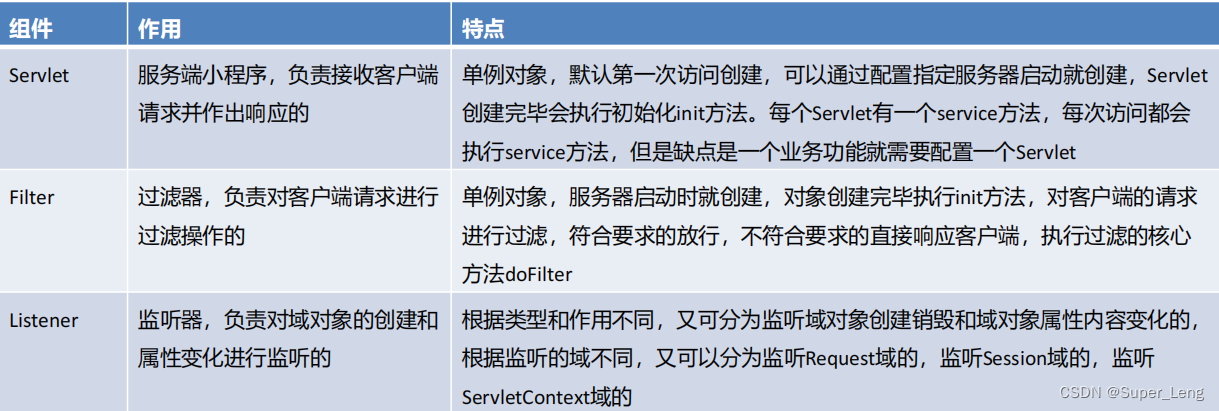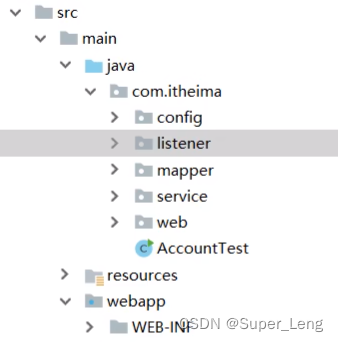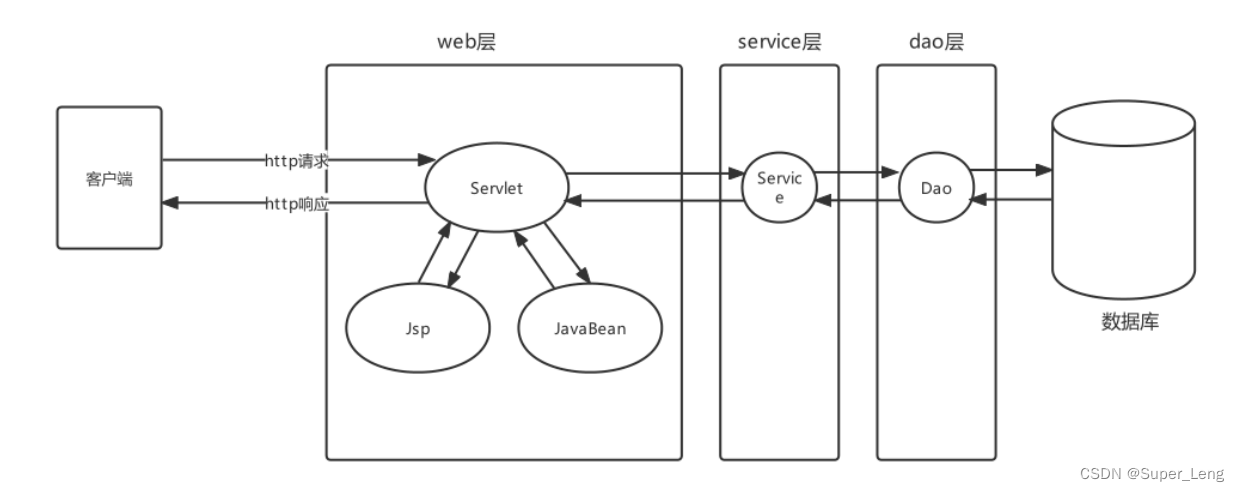一、Javaweb三大组件及环境特点
在Java语言范畴内,web层框架都是基于Javaweb基础组件完成的,所以有必要复习一下Javaweb组件的特点

二、Spring整合web环境的思路及实现
在进行Java开发时要遵循三层架构+MVC,Spring操作最核心的就是Spring容器,web层需要注入Service,service层需要注入Dao(Mapper),web层使用Servlet技术充当的话,需要在Servlet中获得Spring容器
AnnotationConfigApplicationContext applicationContext = new AnnotationConfigApplicationContext(ApplicationContextConfig.class);
AccountService accountService = (AccountService)applicationContext.getBean("accountService");
accountService.transferMoney("tom","lucy",100);
web层代码如果都去编写创建AnnotationConfigApplicationContext的代码,那么配置类重复被加载了,Spring容器也重复被创建了,不能每次想从容器中获得一个Bean都得先创建一次容器,这样肯定是不允许。
所以,我们现在的诉求很简单,如下:
⚫ ApplicationContext创建一次,配置类加载一次;
⚫ 最好web服务器启动时,就执行第1步操作,后续直接从容器中获取Bean使用即可;
⚫ ApplicationContext的引用需要在web层任何位置都可以获取到。
针对以上诉求我们给出解决思路,如下:
⚫ 在ServletContextListener的contextInitialized方法中执行ApplicationContext的创建。或在Servlet的init方法中执行ApplicationContext的创建,并给Servlet的load-on-startup属性一个数字值,确保服务器启动Servlet就创建;
⚫ 将创建好的ApplicationContext存储到ServletContext域中,这样整个web层任何位置就都可以获取到了
自定义代码完成上述ContextLoaderListener和WebApplicationContextUtils
项目结构:

pom.xml文件内容:
<?xml version="1.0" encoding="UTF-8"?>
<project xmlns="http://maven.apache.org/POM/4.0.0"
xmlns:xsi="http://www.w3.org/2001/XMLSchema-instance"
xsi:schemaLocation="http://maven.apache.org/POM/4.0.0 http://maven.apache.org/xsd/maven-4.0.0.xsd">
<modelVersion>4.0.0</modelVersion>
<groupId>com.itheima</groupId>
<artifactId>spring_webmvc_test01</artifactId>
<version>1.0-SNAPSHOT</version>
<packaging>war</packaging>
<dependencies>
<dependency>
<groupId>javax.servlet</groupId>
<artifactId>javax.servlet-api</artifactId>
<version>4.0.1</version>
</dependency>
<dependency>
<groupId>org.springframework</groupId>
<artifactId>spring-web</artifactId>
<version>5.3.7</version>
</dependency>
</dependencies>
</project>
web.xml存放在WEB-INF下:
<?xml version="1.0" encoding="UTF-8"?>
<web-app xmlns="http://xmlns.jcp.org/xml/ns/javaee"
xmlns:xsi="http://www.w3.org/2001/XMLSchema-instance"
xsi:schemaLocation="http://xmlns.jcp.org/xml/ns/javaee http://xmlns.jcp.org/xml/ns/javaee/web-app_3_1.xsd"
version="3.1">
<!--定义全局参数-->
<context-param>
<param-name>contextConfigLocation</param-name>
<!--applicationContext.xml存放在resource目录下-->
<param-value>classpath:applicationContext.xml</param-value>
</context-param>
<!--配置Listener-->
<listener>
<listener-class>org.springframework.web.context.ContextLoaderListener</listener-class>
</listener>
</web-app>
自定义ContextLoaderListener监听器类:
public class ContextLoaderListener implements ServletContextListener {
@Override
public void contextInitialized(ServletContextEvent sce) {
ServletContext servletContext = sce.getServletContext();
// 1. web.xml文件中对应的contextConfigLocation
String contextConfigLocation = servletContext
// 1. 创建Spring容器
ApplicationContext app = new ClassPathXmlApplicationContext("applicationContext.xml");
// 2. 将容器存储到ServletContext域中
sce.getServletContext().setAttribute("applicationContext", app);
}
}
自定义获取全局ApplicationContext的工具类WebApplicationContextUtils:
public class WebApplicationContextUtils {
public static ApplicationContext getWebApplicationContext(ServletContext servletContext) {
ApplicationContext applicationContext = (ApplicationContext) servletContext.getAttribute("applicationContext");
return applicationContext;
}
}
自定义AccountServlet存放在web目录下:
@WebServlet(urlPatterns = "/accountServlet")
public class AccountServlet extends HttpServlet {
protected void doGet(HttpServletRequest request, HttpServletResponse response) throws ServletException, IOException {
// 从ServletContext获得ApplicationContext
ServletContext servletContext = request.getServletContext();
ApplicationContext app = WebApplicationContextUtils.getWebApplicationContext(servletContext);
// web层调用service层,获的AccountService
AccountService accountService = app.getBean(AccountService.class);
accountService.transferMoney("tom","lucy",500);
}
}
三、Spring的web开发组件spring-web
到此,就将一开始的诉求都解决了,当然我们能想到的Spring 框架自然也会想到,Spring其实已经为我们定义好了一个ContextLoaderListener,使用方式跟我们上面自己定义的大体一样,但是功能要比我们强百倍,所以,遵循Spring “拿来主义” 的精神,我们直接使用Spring提供的就可以了,开发如下:
先导入Spring-web的坐标:
<dependency>
<groupId>org.springframework</groupId>
<artifactId>spring-web</artifactId>
<version>5.3.7</version>
</dependency>
在web.xml中去配置ContextLoaderListener,并指定applicationContext.xml配置文件的位置:
<context-param>
<param-name>contextConfigLocation</param-name>
<param-value>classpath:applicationContext.xml</param-value>
</context-param>
<!--spring-web已经提供了ContextLoaderListener,不需要再自己自定义了-->
<!--启动程序后,ContextLoaderListener会解析applicationContext.xml配置文件,并且创建Spring容器-->
<listener>
<listener-class>org.springframework.web.context.ContextLoaderListener</listener-class>
</listener>
ContextLoaderListener源码:
package org.springframework.web.context;
import javax.servlet.ServletContextEvent;
import javax.servlet.ServletContextListener;
public class ContextLoaderListener extends ContextLoader implements ServletContextListener {
public ContextLoaderListener() {
}
public ContextLoaderListener(WebApplicationContext context) {
super(context);
}
/**
* Initialize the root web application context.
*/
@Override
public void contextInitialized(ServletContextEvent event) {
initWebApplicationContext(event.getServletContext());
}
/**
* Close the root web application context.
*/
@Override
public void contextDestroyed(ServletContextEvent event) {
closeWebApplicationContext(event.getServletContext());
ContextCleanupListener.cleanupAttributes(event.getServletContext());
}
}
在Servlet中直接使用:
@WebServlet(urlPatterns = "/accountServlet")
public class AccountServlet extends HttpServlet {
protected void doGet(HttpServletRequest request, HttpServletResponse response) throws ServletException, IOException {
// 从ServletContext获得ApplicationContext
ServletContext servletContext = request.getServletContext();
// spring-web已经提供了WebApplicationContextUtils,不需要再自己自定义了
ApplicationContext app = WebApplicationContextUtils.getWebApplicationContext(servletContext);
// web层调用service层,获的AccountService
AccountService accountService = app.getBean(AccountService.class);
accountService.transferMoney("tom","lucy",500);
}
}
WebApplicationContextUtils源码:

如果核心配置类使用的是注解形式的,那么Spring容器是AnnotationConfigWebApplicationContext,如下配置方式:
public class MyAnnotationConfigWebApplicationContext extends AnnotationConfigWebApplicationContext {
public MyAnnotationConfigWebApplicationContext(){
//注册核心配置类
super.register(ApplicationContextConfig.class);
}
}
<context-param>
<param-name>contextClass</param-name>
<param-value>com.itheima.web.MyAnnotationConfigWebApplicationContext</param-value>
</context-param>
<listener>
<listener-class>org.springframework.web.context.ContextLoaderListener</listener-class>
</listener>
四、web层MVC框架思想与设计思路
Java程序员在开发一般都是MVC+三层架构,MVC是web开发模式,传统的Javaweb技术栈实现的MVC如下:

原始Javaweb开发中,Servlet充当Controller的角色,Jsp充当View角色,JavaBean充当模型角色,后期Ajax异
步流行后,在加上现在前后端分离开发模式成熟后,View就被原始Html+Vue替代。原始Javaweb开发中,
Service充当Controller有很多弊端,显而易见的有如下几个:

负责共有行为的Servlet称之为前端控制器,负责业务行为的JavaBean称之为控制器Controller
